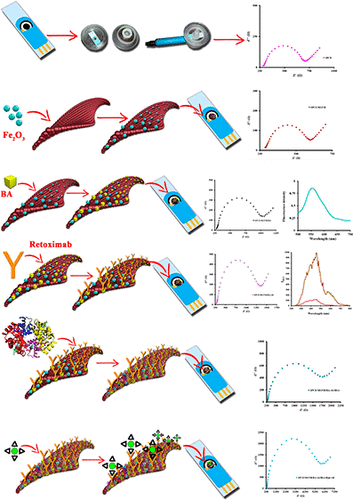当前位置:
X-MOL 学术
›
Anal. Chem.
›
论文详情
Our official English website, www.x-mol.net, welcomes your feedback! (Note: you will need to create a separate account there.)
Well-Orientation Strategy for Direct Immobilization of Antibodies: Development of the Immunosensor Using the Boronic Acid-Modified Magnetic Graphene Nanoribbons for Ultrasensitive Detection of Lymphoma Cancer Cells.
Analytical Chemistry ( IF 7.4 ) Pub Date : 2020-07-20 , DOI: 10.1021/acs.analchem.0c02357 Pegah Hashemi 1 , Abbas Afkhami 1 , Behzad Baradaran 2 , Raheleh Halabian 3 , Tayyebeh Madrakian 1 , Fabiana Arduini 4 , Tien Anh Nguyen 5 , Hasan Bagheri 6
Analytical Chemistry ( IF 7.4 ) Pub Date : 2020-07-20 , DOI: 10.1021/acs.analchem.0c02357 Pegah Hashemi 1 , Abbas Afkhami 1 , Behzad Baradaran 2 , Raheleh Halabian 3 , Tayyebeh Madrakian 1 , Fabiana Arduini 4 , Tien Anh Nguyen 5 , Hasan Bagheri 6
Affiliation

|
This work presents an effective strategy for the well-oriented immobilization of antibodies in which boronic acid is directly attached to the surface and with no need of the long and flexible spacer. A magnetic graphene nanoribbon–boronic-acid-based immunosensor was developed and tested for the impedimetric detection of lymphoma cancer cells, a blood cancer biomarker. Magnetic graphene nanoribbons (MGNRs) were modified with boronic acid (BA) to create a supporting matrix that is utilized by immobilizing anti-CD20 antibodies with good orientation. The prepared biosensing layer (MGNR/BA/Ab) with well-oriented antibodies was premixed into whole blood samples to interact with lymphoma cancer cell receptors. In the presence of target cell receptors, an immunocomplex was formed between anti-CD20 antibodies and lymphoma cancer cell receptors. Then, the biosensing layer was magnetically collected on a screen-printed carbon electrode (SPCE) and placed in a homemade electrochemical cell configuration to measure impedimetric signals. The fabrication steps of the immunosensor were characterized by various techniques, such as resonance light scattering, fluorescence, electrochemical impedance spectroscopy, and cyclic voltammetry. The assay is highly sensitive: the calculated limit of detection of lymphoma cancer cells was as low as 38 cells/mL, and the detection was linear from 100 to 1 000 000 cells/mL. The specificity of the immunosensor is also very high, and there is no interference effect with several potential interferents, such as the breast cancer (MCF-7), human embryonic kidney (HEK293), and leukemia (HL-60 and KCL-22) cell lines. The performance of the immunosensor for lymphoma cancer cells in clinical blood samples is consistent with that of commercial flow cytometric assays.
中文翻译:

直接固定抗体的良好定向策略:使用硼酸修饰的磁性石墨烯纳米带开发的免疫传感器,用于淋巴瘤癌细胞的超灵敏检测。
这项工作为抗体的定向固定化提供了有效的策略,其中硼酸直接附着在表面上,不需要长而灵活的间隔子。开发了基于磁性石墨烯纳米带-硼酸的免疫传感器,并对其进行了阻抗测定,以检测血癌的生物标志物淋巴瘤癌细胞。用硼酸(BA)修饰磁性石墨烯纳米带(MGNR),以创建支持基质,该基质可通过固定具有良好方向的抗CD20抗体来使用。将制备好的具有良好定向抗体的生物传感层(MGNR / BA / Ab)预混到全血样品中,以与淋巴瘤癌细胞受体相互作用。在靶细胞受体的存在下,抗CD20抗体和淋巴瘤癌细胞受体之间形成了免疫复合物。然后,将生物传感层磁性收集在丝网印刷的碳电极(SPCE)上,并置于自制的电化学电池配置中以测量阻抗信号。免疫传感器的制造步骤通过多种技术进行了表征,例如共振光散射,荧光,电化学阻抗谱和循环伏安法。该测定法非常灵敏:淋巴瘤癌细胞的计算检出限低至38细胞/ mL,检测范围从100到1000000细胞/ mL是线性的。免疫传感器的特异性也很高,并且对几种潜在的干扰物没有干扰作用,例如乳腺癌(MCF-7),人胚肾(HEK293)和白血病(HL-60和KCL-22)细胞系。
更新日期:2020-08-18
中文翻译:

直接固定抗体的良好定向策略:使用硼酸修饰的磁性石墨烯纳米带开发的免疫传感器,用于淋巴瘤癌细胞的超灵敏检测。
这项工作为抗体的定向固定化提供了有效的策略,其中硼酸直接附着在表面上,不需要长而灵活的间隔子。开发了基于磁性石墨烯纳米带-硼酸的免疫传感器,并对其进行了阻抗测定,以检测血癌的生物标志物淋巴瘤癌细胞。用硼酸(BA)修饰磁性石墨烯纳米带(MGNR),以创建支持基质,该基质可通过固定具有良好方向的抗CD20抗体来使用。将制备好的具有良好定向抗体的生物传感层(MGNR / BA / Ab)预混到全血样品中,以与淋巴瘤癌细胞受体相互作用。在靶细胞受体的存在下,抗CD20抗体和淋巴瘤癌细胞受体之间形成了免疫复合物。然后,将生物传感层磁性收集在丝网印刷的碳电极(SPCE)上,并置于自制的电化学电池配置中以测量阻抗信号。免疫传感器的制造步骤通过多种技术进行了表征,例如共振光散射,荧光,电化学阻抗谱和循环伏安法。该测定法非常灵敏:淋巴瘤癌细胞的计算检出限低至38细胞/ mL,检测范围从100到1000000细胞/ mL是线性的。免疫传感器的特异性也很高,并且对几种潜在的干扰物没有干扰作用,例如乳腺癌(MCF-7),人胚肾(HEK293)和白血病(HL-60和KCL-22)细胞系。

























 京公网安备 11010802027423号
京公网安备 11010802027423号